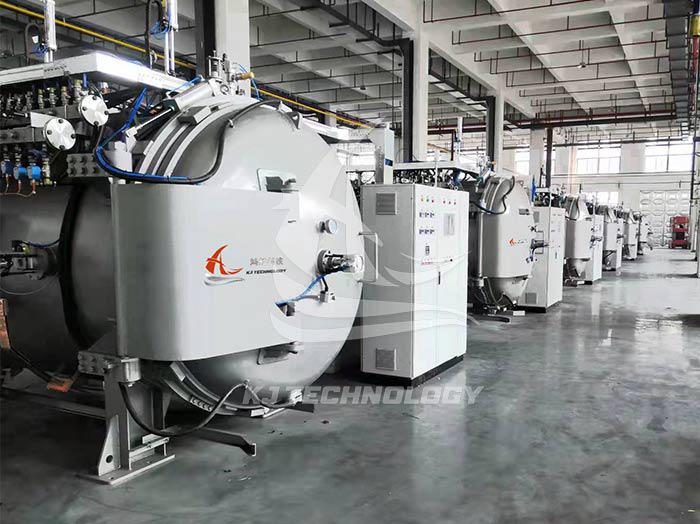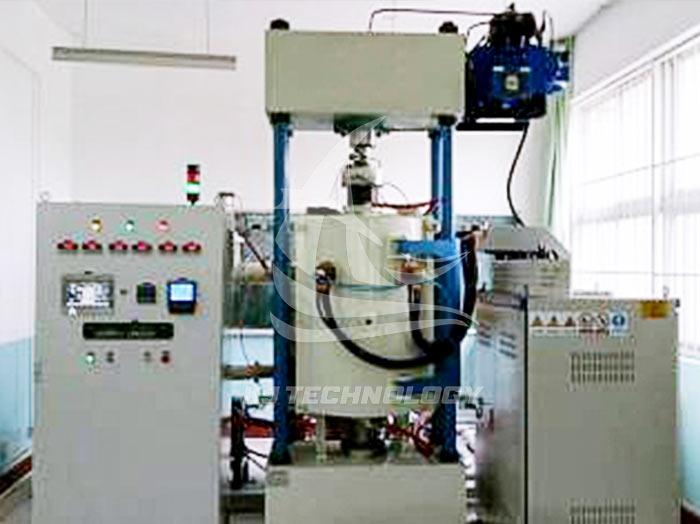Application field of industrial large-scale vacuum electric furnace
 11-14-2025 Author: KJ technology
11-14-2025 Author: KJ technology
Industrial large-scale vacuum furnaces play a key role in multiple high-end manufacturing fields due to their advantages of non oxidation, high-precision temperature control, and clean treatment. Their core application areas and values are as follows:
1. Aerospace field: Core processing equipment for high-performance materials
High temperature alloy treatment
Application scenario: Key components such as aircraft engine blades and turbine disks need to withstand extreme high temperatures and stresses. Vacuum electric furnaces use solid solution aging treatment (such as Inconel 718 alloy cooling after insulation at 720 ℃) to improve material creep resistance and extend service life.
Technical advantages: Vacuum environment avoids oxidation, while precise temperature control ensures tissue uniformity, improving the fatigue life of blades.
Titanium alloy processing
Application scenario: Titanium alloys (such as Ti-6Al-4V) are used for aircraft structural components, which require vacuum annealing to eliminate processing stress and restore plasticity.
Technical advantage: After vacuum annealing, the elongation of titanium alloy is increased, which is convenient for subsequent forming or machining.
2. Semiconductor and Electronics Industry: The Foundation of Precision Manufacturing
Preparation of Semiconductor Materials
Application scenarios: Silicon wafer diffusion, oxidation, and integrated circuit packaging testing require ultra-high purity environments. Vacuum furnaces reduce lattice defects and improve device performance through precise temperature control (± 1.5 ℃) and pollution-free treatment.
Case: Vacuum treatment of third-generation semiconductor materials (such as silicon carbide) can reduce defect density, improve thermal conductivity and voltage resistance.
High precision welding
Application scenario: Vacuum brazing of stainless steel and high-temperature alloys to achieve seamless connection of microelectronic devices such as integrated circuits and transistors.
Technical advantages: Vacuum environment avoids oxidation, improves welding strength, and reduces porosity defects.
3. Metallurgy and metal processing: dual improvement of purity and performance
Vacuum smelting
Application scenarios: Smelting magnetic materials (such as neodymium iron boron), electrical materials, nuclear fuels, etc., improving metal purity by removing gases and impurities.
Technical advantage: After vacuum smelting, the oxygen content in the metal is reduced to below 10ppm, significantly improving magnetic properties and corrosion resistance.
Special metal heat treatment
Application scenarios: Annealing and quenching of elastic materials and high melting point metals (such as tungsten and molybdenum) to eliminate internal stress and enhance toughness.
Case: After vacuum quenching, the hardness of high-speed steel cutting tools reaches 62-65HRC, and there is no oxide layer, resulting in a 2-fold increase in wear resistance.
4. Chemical and Petrochemical Industry: Solutions for Corrosion Resistance and High Temperature Reactions
Special environmental reactions
Application scenario: Catalytic reactions under high temperature, high pressure, and corrosive environments (such as catalyst activation and regeneration), achieved through the sealing and corrosion resistance of vacuum electric furnaces.
Technical advantages: Vacuum environment reduces side reactions, improves catalyst efficiency and lifespan.
powder metallurgy
Application scenario: Vacuum sintering of hard alloys (such as tungsten cobalt alloys), densification achieved through high-pressure gas quenching, and preparation of parts with higher density.
Case: Vacuum sintered hard alloy cutting tools have a longer service life than traditional processes.
5. New Energy and Additive Manufacturing: Empowerors in Emerging Fields
Lithium battery material processing
Application scenario: Vacuum sintering of positive electrode materials (such as lithium nickel cobalt manganese oxide), optimization of crystal structure, and improvement of battery energy density and cycle life.
Technical advantage: Vacuum environment avoids material oxidation and ensures the stability of electrochemical performance.
Post processing of metal 3D printing
Application scenario: Vacuum annealing of 3D printed titanium alloy and nickel based alloy parts to eliminate printing stress and improve mechanical performance.
Case: After 3D printing of aviation components, vacuum annealing improves fatigue life.
6. Research and high-end manufacturing: an experimental platform for material innovation
New material research and development
Application scenario: Vacuum synthesis of nanomaterials and superconducting materials, promoting material formation and growth through precise temperature and atmosphere control.
Case: Vacuum annealing of nanocrystalline alloys with grain size controlled between 10-50nm significantly improves magnetic properties.
Single crystal growth
Application scenario: Single crystal drawing of semiconductor materials such as silicon and germanium, vacuum environment to avoid impurity pollution and improve crystal quality.
Technical advantage: The defect density of single crystal is reduced to below 10 ³/cm ², meeting the needs of high-end chips.








